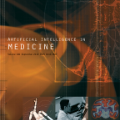Network slicing is a well assessed approach enabling virtualization of the mobile core and radio access network (RAN) in the emerging 5th Generation New Radio. Slicing is of paramount importance when dealing with the emerging and diverse vertical applications entailing heterogeneous sets of requirements. 5G is also envisioning Unmanned Aerial Vehicles (UAVs) to be a key element in the cellular network standard, aiming at their use as aerial base stations and exploiting their flexible and quick deployment to enhance the wireless network performance. This work presents a UAV-assisted 5G network, where the aerial base stations (UAV-BS) are empowered with network slicing capabilities aiming at optimizing the Service Level Agreement (SLA) satisfaction ratio of a set of users. The users belong to three heterogeneous categories of 5G service type, namely, enhanced mobile broadband (eMBB), ultra-reliable low-latency communication (URLLC), and massive machine-type communication (mMTC). A first application of multi-agent and multi-decision deep reinforcement learning for UAV-BS in a network slicing context is introduced, aiming at the optimization of the SLA satisfaction ratio of users through the joint allocation of radio resources to slices and refinement of the UAV-BSs 2-dimensional trajectories. The performance of the presented strategy have been tested and compared to benchmark heuristics, highlighting a higher percentage of satisfied users (at least 27% more) in a variety of scenarios.
翻译:5G还设想将无人驾驶航空飞行器(UAV-BS)作为移动网络标准中的一个关键要素,目的是将其用作空中基地站,并利用其灵活和迅速的部署来提高无线网络的性能。这项工作提供了一个UAV协助的5G网络,使空基站(UAV-BS)拥有网络定位能力,以优化一组用户的服务级协议(SLA)满意率。用户属于三类5G服务类型,即增强的移动宽带(EMBBB)、超可弹性低热通信(URLLC)和大规模机器型通信(mMTC),目的是将其用作空基站,并利用其灵活和快速部署的部署来提高无线网络的性能。在网络定位背景下,首次为空基站(UAV-BS)提供多试和多度深度强化学习,目的是优化SAVA-BS用户的服务级别协议(SLA)满意度比率。通过联合测试的性能比试定式BS2级用户的平级战略比例。



